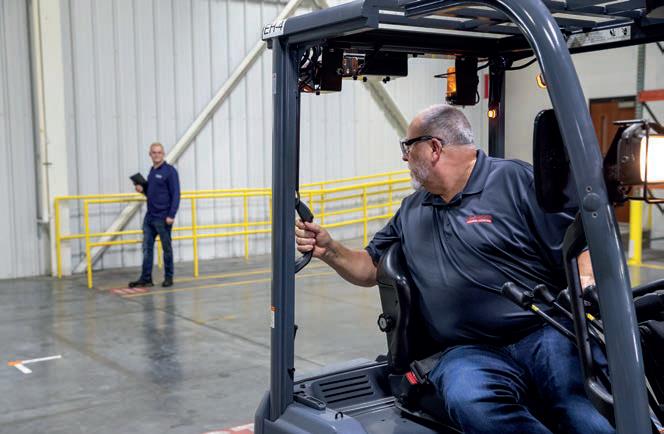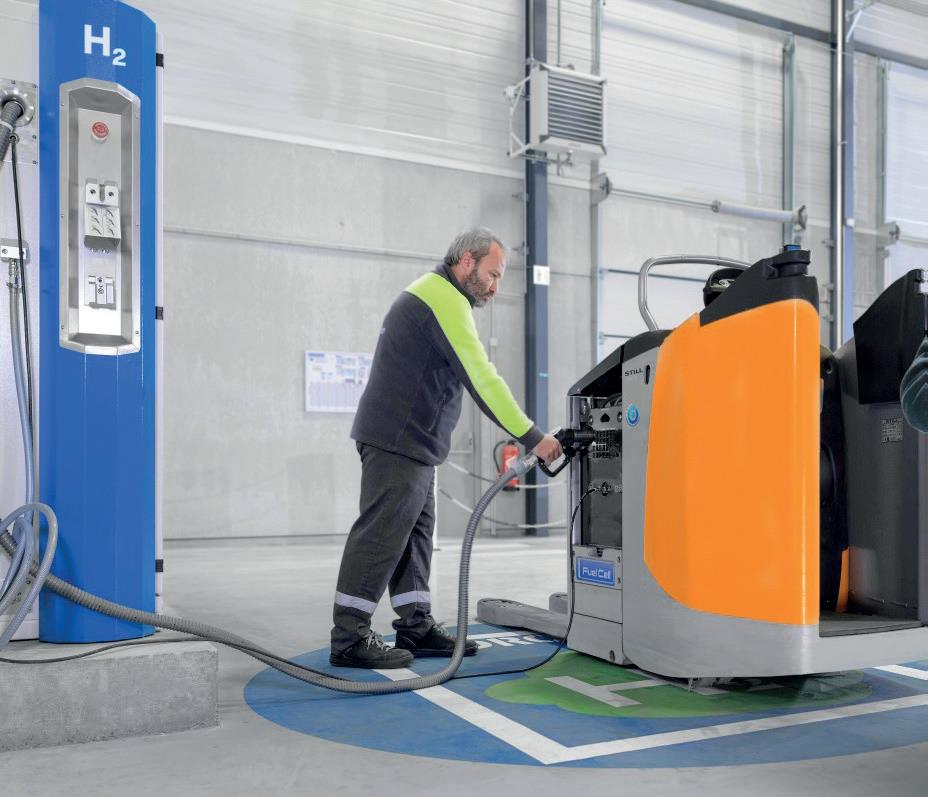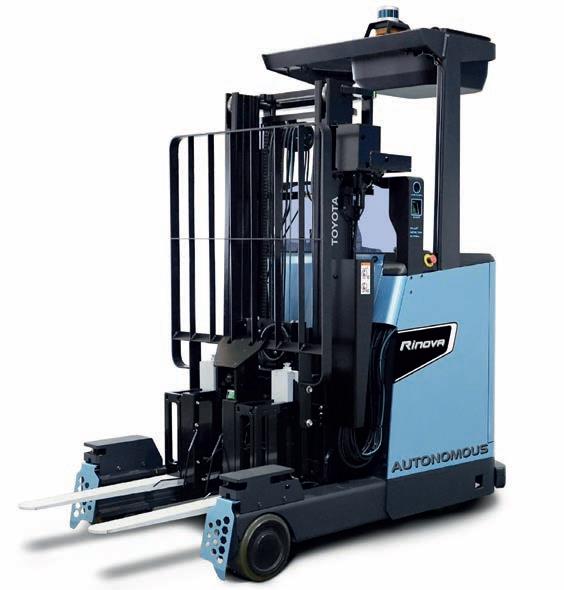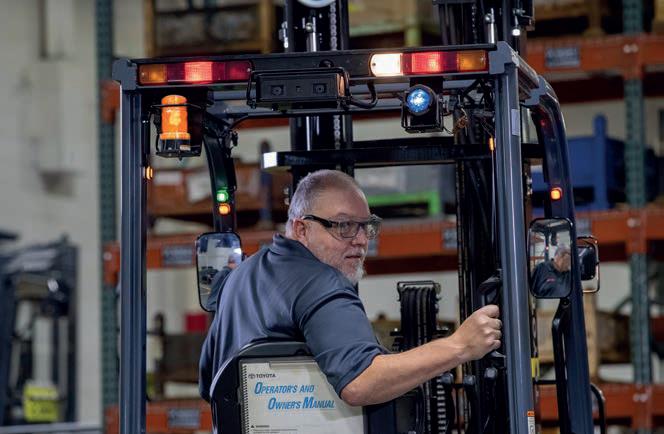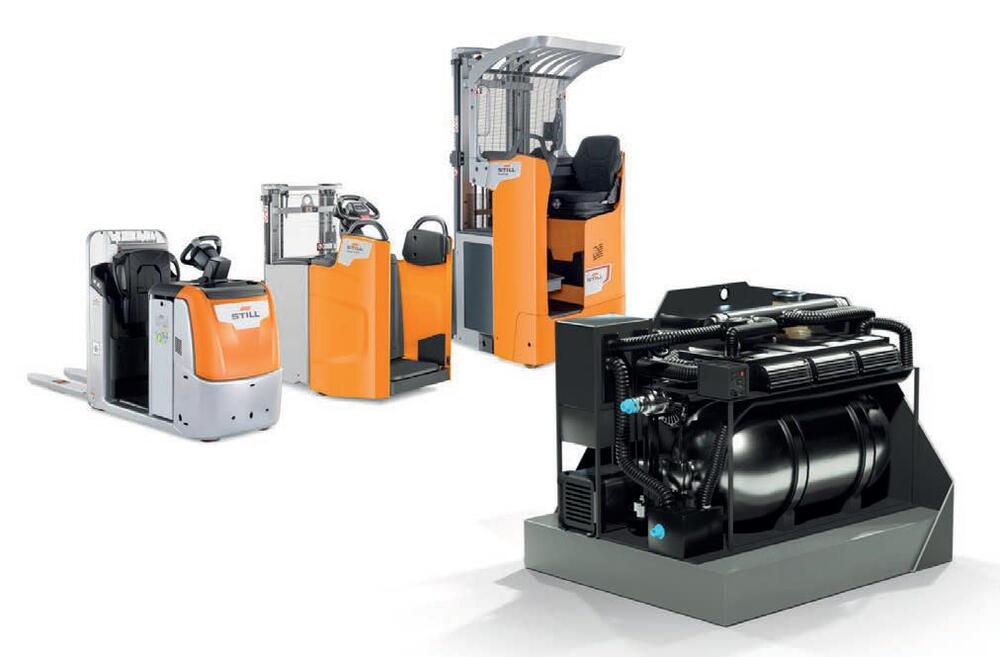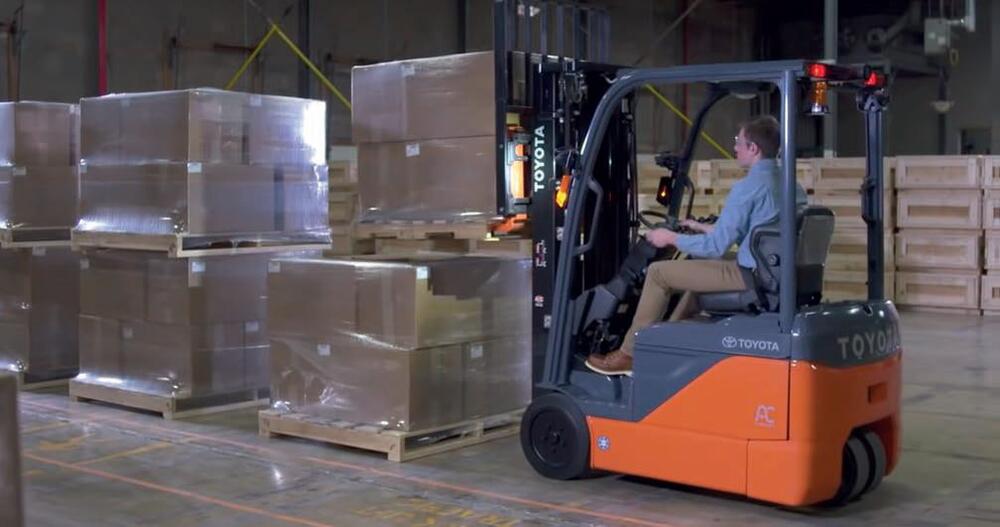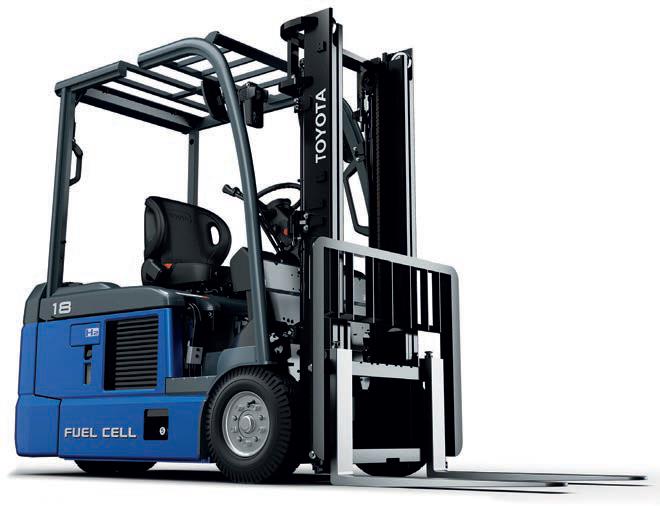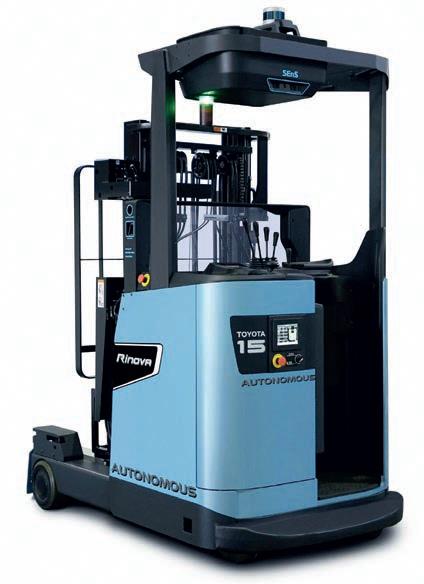Forklifts: Two-pronged attack
13 April 2023There has been no shortage of new products and technology from the forklift industry’s heavy hitters. Jack Carfrae rounds up the latest launches and developments.
Shaky economic ground and sluggish supply chains have been the norm the world over for a long time, and no industry is immune from them – least of all one that relies on heavy mechanical equipment. It stands to reason that development and new product launches should suffer as a result, but forklift manufacturers have pressed on regardless. The sector’s largest companies have launched a swathe of new products and showcased some of the most advanced technology in materials handling in the past few months alone, so they show no signs of slowing down.
As you might expect from the biggest player in the forklift market, Toyota Material Handling Japan (TMHJ) is at the sharp end of technological developments, which include a new Fuel Cell Lift Truck and Autonomous Lift Truck for Truck Loading, both launched in September to coincide with the Logis-Tech Tokyo 2022 trade show.
The former is an updated version of the company’s original Fuel Cell (which it refers to simply as FC) Lift Truck, which launched in Japan in 2016. It claims that the latest model is 30% cheaper than its predecessor due to a reduction in the cost of the FC system that, incidentally, is shared with the Mirai passenger car. Along with a lower number of parts in the FC system itself when compared with the outgoing model, Toyota credited the practice of sharing tech between its automotive and materials handling divisions as the reason for the truck’s lower cost. It has a suggested retail price of Y10,978,000 including tax (circa $85,400 at the time of writing).
The firm says the truck generates zero CO2 emissions, can be refuelled in three minutes, and has an eight-hour operating time and a 1.75t load capacity.
It is also said to be twice as robust as the outgoing model, courtesy of a “power generation control system” that “suppresses FC deterioration,” according to the manufacturer. That allegedly allows customers to run it for longer, which is handy when previous FC truck users have included factories, airports and markets “with long operating hours and frequent use”.
The catchily titled Autonomous Lift Truck for Truck Loading uses what TMHJ claims is “world-first” artificial intelligence, along with a 3D-lidar (light detection and ranging) system, which means it can automatically recognise the location and position of other trucks and loads and create routes to and from loading areas. The company says it can automate the entire lifting and loading operation, both for fixed position lifting and even when the location changes.
At the less futuristic end of the spectrum, TMH’s North American arm released a refreshed version of its Three-Wheel Electric Forklift in October. Said to be the best-selling truck in the segment, it has been subject to more than 30 updates, including a system known as Automatic Mast Control, which independently improves load stability, along with a cushioning function to reduce wear and tear on the mast. The basic model has a 3,000-4,000lb load capacity, an AC drive motor, and what TMH describes as “industry-leading travel times”.
Toyota says the standard model will run for 40% longer on a single charge than its predecessor, while an optional lithium-ion battery is said to reduce maintenance costs and downtime.
Along with the manufacturer’s other new models, the Three-Wheel Electric Forklift is also available with TMH’s Smart Environment Sensor – SEnS+ – pedestrian and object detection technology, itself a new addition in October. It is another example of the company borrowing technology from its automobile division, because SEnS+ is effectively a series of visual and audible alerts that kick in when the truck nears objects or pedestrians (it can differentiate between the two) – think parking cameras and sensors in a modern car. It can also engage the truck’s regenerative braking system to restrict movement if it detects something in close range.
SEnS+ forms part of a wider package of safety and driver assistance features known as Toyota Assist, comprising the firm’s System of Active Stability (SAS), which stabilises the rear axle when it senses that the forklift is unbalanced; the EZ Control Joystick – all hydraulic controls, travel direction and horn button are bundled into one handle; a series of adjustable cameras; auto height select; load weight sensing ground-level monitoring; and more.
There is plenty going on beyond Toyota’s tech-heavy headlines and, in Germany, local heavy-hitter the Kion Group’s two forklift brands – Still and Linde – have been no less busy.
The former company announced a series of initiatives in September, including splitting its products into two categories: Xcellence Line and Classic Line. Xcellence Line is made up of its most advanced models, including the forthcoming RXE electric truck series, said to be much more efficient than the outgoing RX line it replaces. Classic Line covers entrylevel forklifts that, according to Still, are “standardised, quickly available, and at an attractive price point”. It hopes they will help it tap into the lower end of the market, in which it has previously played only a minor role.
Fellow German giant and Kion Group competitor Jungheinrich also made a move at the bottom end of the forklift market in late 2022. It launched its series of EFG electric trucks in December, described as “cost-effective entry-level models for classic transport and stacking tasks between 1.6 and 3.0 tons”. The EFG BB and BC series forklifts are available in three and four-wheel guises and use 48V batteries. They are available with three different mast types and in a variety of different sizes and designs, with lifting heights of up to 6,500mm.
“With our new EFG series, we are deliberately targeting small and medium-sized companies and their particular needs: low acquisition costs, fast delivery times, and solid basic equipment,” says chief sales officer, Christian Erlach.
Like Toyota, Hamburg-based Still has been dabbling in hydrogen fuel cell technology and intends to up the ante. In October, it announced plans to launch its own 24V fuel cell system for warehouse trucks. The move adds hydrogen fuelling infrastructure to its product portfolio, on top of building forklift truck fuel cell systems at its own factory, and the firm claims to be the first European original equipment manufacturer (OEM) to manufacture fuel cell systems – also known as battery replacement modules – at its own production facility.
Rather than going down the high-tech hydrogen fuel cell route, Still’s sister-firm Linde approved hydrotreated vegetable oil (HVO) for its diesel-engined forklifts in September. The fuel is said to cut CO2 emissions by up to 90%, render the engines more powerful, requires no adaptation of existing fuelling infrastructure, and can be blended with conventional diesel. Linde concedes that the price of HVO is “slightly higher than that of standard diesel” but says the extra outlay is “more than offset by the improved sustainability factor”.
“We are giving our customers the chance to massively reduce the carbon footprint of their diesel forklifts without having to invest a single cent in additional infrastructure,” says Frank Bergmann, senior product manager for counterbalanced forklifts.
In November, Linde made its trucks bomb-proof – literally – when it launched explosion-resistant versions of its E-truck series of electric counterbalance forklifts. Unveiled at the Dangerous Goods/ Hazardous Substances trade fair in Leipzig, Germany, the firm’s E25 to E35 models can now be ordered to Atex (European directives for controlling explosive atmospheres) zone 2/22 specification, while versions built to zone 1/21 standard are due to follow in mid-2023.
There are too many specialist safety features to list here, but among the highlights are the position of the cockpit, which is largely decoupled from the drive unit and mast. An elastomer ring bearing is used for shock absorption on the front axle, both to safeguard the driver and to render the truck more comfortable over bumpy surfaces. An electronic temperature monitoring system on the traction motors is linked to a safety warning and shutdown function, and all the electronic controls, sensors, fuses and relays are bundled into in a pressure-resistant control housing at the rear of the truck. Plastic trim, floor mats and tyres, as well as seat upholstery and armrests made of dissipative material, all protect against static charges
Fair and square
Jungheinrich’s latest offering in the forklift market – the EFG series – might be cheap and cheerful, but its other recent addition to the materials handling world is anything but. In November, the company announced it had received its first order of its PowerCube – an automated compact container warehouse with 18,000 storage locations within 400m2 of floor space, said to be capable of “150 retrievals and putaways per hour” of small parts and goods.
Unveiled at LogiMat 2022, the PowerCube specialises in high storage density and automation. It features a modular racking system mounted above a series of ‘shuttles’, which move at up to 4m per second, accelerate at up to 2m per second, and store and retrieve up to two vertically stacked totes at a time.
The system operates at up to 12m, which, according to Jungheinrich, renders it the highest compact tote warehouse in its class. Swiss firm M. Schönenberger AG made the order for its site in Mellingen, which tops out at 10.4m and comprises 25 storage levels, each of which can be filled with a load of up to 50kg. It will be capable of up to 130 retrievals and 20 returns for stock replenishment per hour.
Best of the rest
US giant Hyster-Yale Group announced new releases from its namesake forklift brands in summer 2022. Yale launched the ERP series of three- and four-wheel electric trucks in July, complete with a lithium-ion battery and a 4,000lb capacity. They are said to be more efficient, more ergonomic and stabler than their predecessors.
The following month, Hyster also announced a 4,000-pound capacity lithium-ion battery truck. Known as the J40XNL, it is designed for the trucking industry and features elements such as a low step height and an optional “trucker’s mast” to minimise the risk of trailer and bay damage.
In November, Chinese firm Heli launched its new K2 series 5.0 to 10-ton internal combustion forklift and, in the same month in Tokyo, Mitsubishi Heavy Industries (MHI) and Mitsubishi Logisnext announced what they described as a demonstration of their automated picking solution for beverage warehouses.
A collaboration with Kirin Beverage and Kirin Group Logistics, the project is taking place at the LogiQ X Lab demonstration facility at the Yokohama Hardtech Hub, will run until June 2023, and is yet another example of the move towards automation for lifting equipment. MHI’s automated picking solution employs automated guided forklifts (AGFs) to retrieve items from storage areas and pass them on to automated guided vehicles (AGVs) and palletisers. More AGFs and AGVs are then employed to transfer the items to storage shelves.
MHI says the initiative is designed both as a “verification” of its automated picking solution and to establish which areas of Kirin’s warehouse are best suited to automated and manual labour, although it ultimately aims to reduce the latter.
